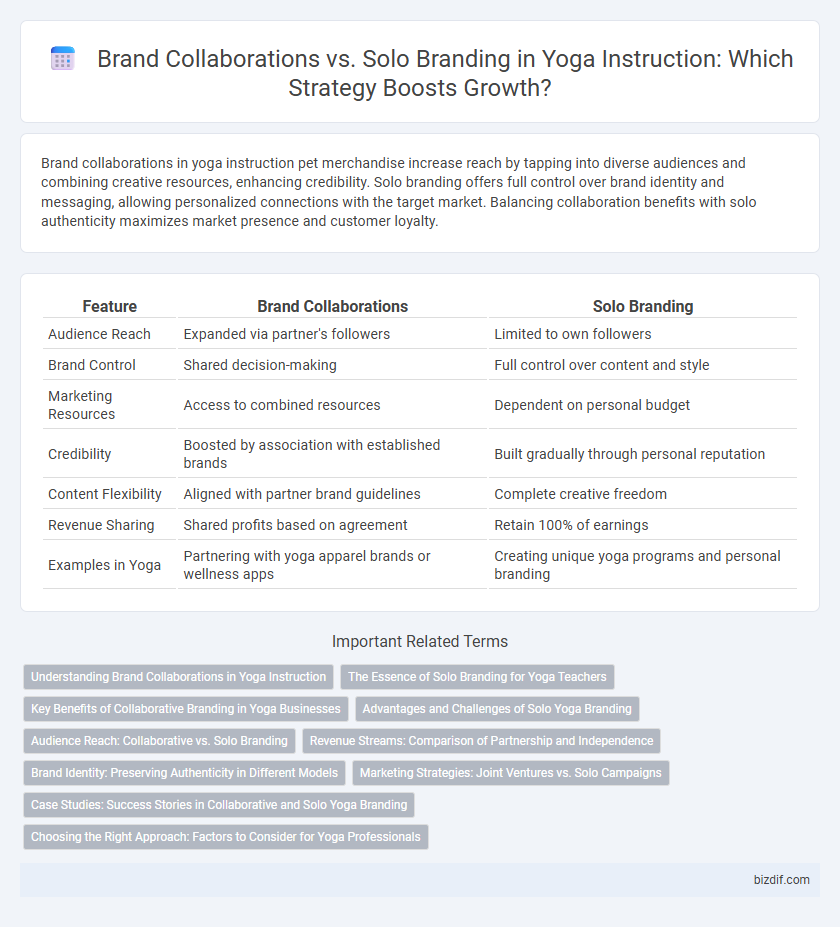Brand collaborations in yoga instruction pet merchandise increase reach by tapping into diverse audiences and combining creative resources, enhancing credibility. Solo branding offers full control over brand identity and messaging, allowing personalized connections with the target market. Balancing collaboration benefits with solo authenticity maximizes market presence and customer loyalty.
Table of Comparison
| Feature | Brand Collaborations | Solo Branding |
|---|---|---|
| Audience Reach | Expanded via partner's followers | Limited to own followers |
| Brand Control | Shared decision-making | Full control over content and style |
| Marketing Resources | Access to combined resources | Dependent on personal budget |
| Credibility | Boosted by association with established brands | Built gradually through personal reputation |
| Content Flexibility | Aligned with partner brand guidelines | Complete creative freedom |
| Revenue Sharing | Shared profits based on agreement | Retain 100% of earnings |
| Examples in Yoga | Partnering with yoga apparel brands or wellness apps | Creating unique yoga programs and personal branding |
Understanding Brand Collaborations in Yoga Instruction
Brand collaborations in yoga instruction leverage the combined strengths of multiple practitioners or related wellness brands to expand audience reach and enhance credibility. Partnering with complementary yoga instructors, eco-friendly apparel companies, or holistic health services creates a cohesive brand experience that appeals to a broader demographic. This cooperative approach often leads to increased visibility, shared marketing costs, and enriched content offerings compared to solo branding efforts.
The Essence of Solo Branding for Yoga Teachers
Solo branding for yoga teachers emphasizes authentic connection and personalized teaching style, allowing instructors to showcase their unique approach and values. This strategy builds trust and loyalty by fostering a direct relationship with students, enhancing long-term engagement and community growth. Prioritizing solo branding enables yoga teachers to retain creative control and establish a distinct presence in a competitive wellness market.
Key Benefits of Collaborative Branding in Yoga Businesses
Collaborative branding in yoga businesses amplifies reach by tapping into diverse audiences and authentic community connections, enhancing brand visibility and trust. Shared resources and expertise lead to innovative class offerings and marketing strategies, fostering a more dynamic and appealing yoga experience. Collaborative efforts also drive cost efficiency and create powerful referral networks, ultimately boosting client retention and business growth.
Advantages and Challenges of Solo Yoga Branding
Solo yoga branding offers the advantage of complete creative control, allowing instructors to tailor their brand identity closely to their unique teaching style and values. It fosters a direct and personal connection with clients, enhancing trust and loyalty but requires significant effort in self-promotion and marketing to build visibility from the ground up. Challenges include limited resources compared to brand collaborations, making it harder to scale rapidly or access broader audiences without partnerships or extensive networking.
Audience Reach: Collaborative vs. Solo Branding
Brand collaborations in yoga instruction amplify audience reach by merging follower bases, creating diverse and engaged communities that solo branding often cannot achieve alone. Collaborative branding leverages shared resources and networks, enhancing visibility across multiple platforms and attracting a broader demographic. In contrast, solo branding offers more control and a distinct personal identity but may experience slower audience growth and limited exposure outside existing followers.
Revenue Streams: Comparison of Partnership and Independence
Brand collaborations in yoga instruction often generate diversified revenue streams through shared marketing, co-branded products, and expanded audience reach, enhancing overall profitability. Solo branding allows instructors to retain full control over pricing and client relationships, maximizing direct income but relying solely on personal marketing efforts. Choosing between partnerships and independence depends on whether the priority is revenue growth through collaboration or maintaining autonomy with concentrated income sources.
Brand Identity: Preserving Authenticity in Different Models
Brand collaborations in yoga instruction create opportunities to expand reach while merging distinct identities, yet maintaining core values ensures authenticity remains intact. Solo branding emphasizes a unified, personal narrative that deeply connects with followers and reinforces trust. Balancing collaboration benefits with strong brand identity safeguards the integrity and unique voice essential for long-term success.
Marketing Strategies: Joint Ventures vs. Solo Campaigns
Joint ventures in yoga instruction marketing leverage combined brand equity, pooling resources to expand reach through co-branded workshops, social media campaigns, and affiliate promotions, boosting client engagement and increasing conversion rates. Solo branding strategies prioritize personal brand identity, delivering tailored messaging and authentic storytelling that cultivates trust and loyalty within a niche audience, often resulting in higher retention and lifetime customer value. Effective marketing requires analyzing target demographics, budget allocation, and long-term goals to decide between collaborative campaigns or solo initiatives for maximizing brand visibility and revenue growth.
Case Studies: Success Stories in Collaborative and Solo Yoga Branding
Case studies in yoga branding reveal distinct advantages of both brand collaborations and solo branding approaches. Collaborative efforts, such as the partnership between Alo Yoga and Gaiam, leverage combined audiences and diverse expertise, resulting in amplified brand visibility and innovative product lines. In contrast, solo branding success stories like Yoga with Adriene demonstrate the power of personal connection and consistent content delivery in cultivating a dedicated community and strong brand loyalty.
Choosing the Right Approach: Factors to Consider for Yoga Professionals
Yoga professionals must evaluate target audience alignment, brand values, and long-term business goals when choosing between brand collaborations and solo branding. Collaborations can expand reach and credibility by leveraging established networks, while solo branding allows for full creative control and authentic self-expression. Assessing resource availability, market positioning, and desired growth trajectory ensures the chosen approach effectively supports career development and client engagement.
Brand collaborations vs Solo branding Infographic

 bizdif.com
bizdif.com